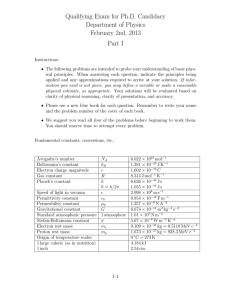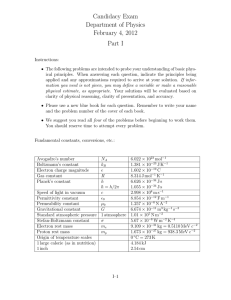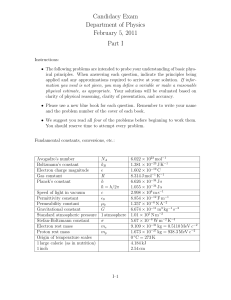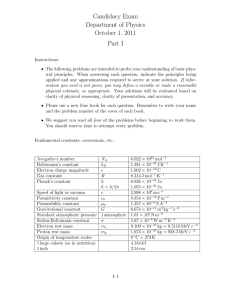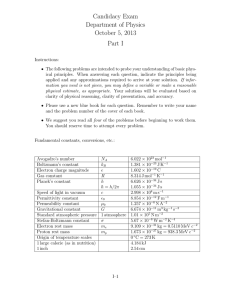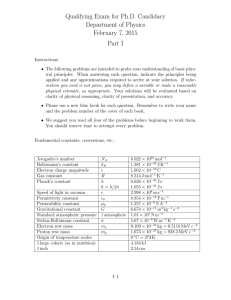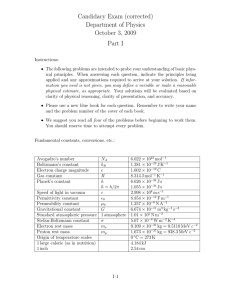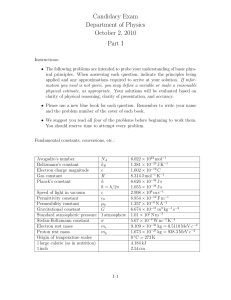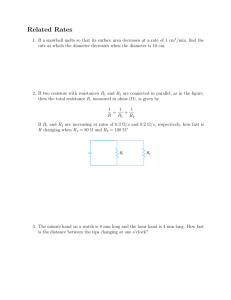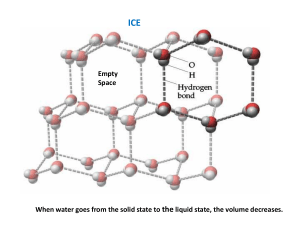Candidacy Exam Department of Physics October 6, 2012 Part I
advertisement
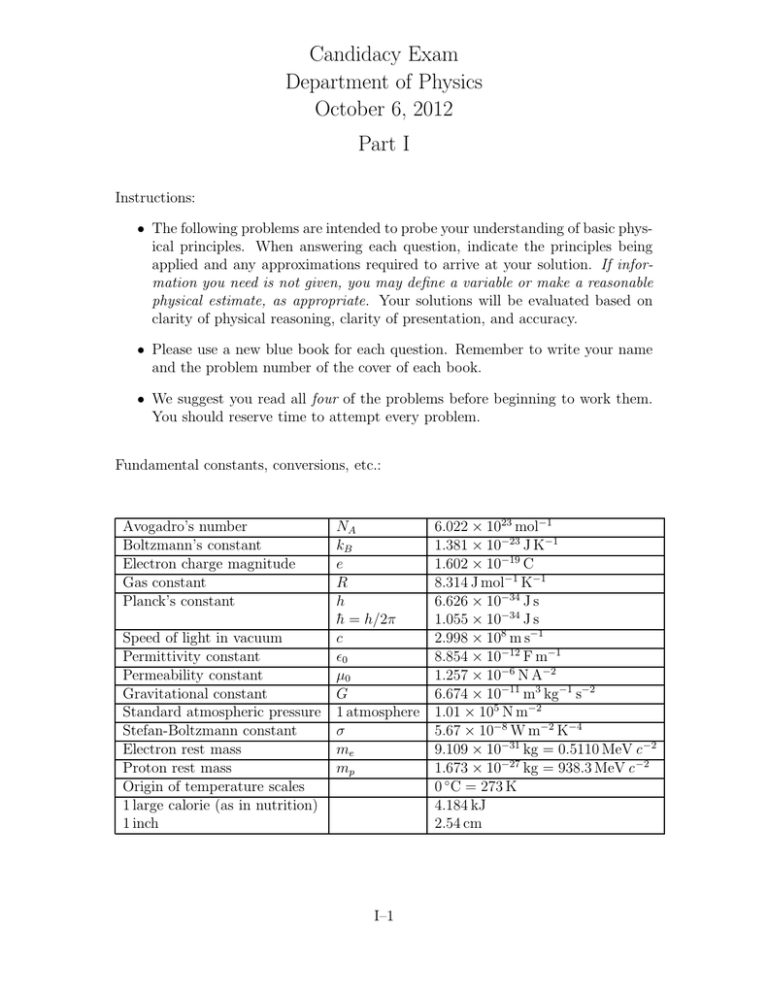
Candidacy Exam Department of Physics October 6, 2012 Part I Instructions: • The following problems are intended to probe your understanding of basic physical principles. When answering each question, indicate the principles being applied and any approximations required to arrive at your solution. If information you need is not given, you may define a variable or make a reasonable physical estimate, as appropriate. Your solutions will be evaluated based on clarity of physical reasoning, clarity of presentation, and accuracy. • Please use a new blue book for each question. Remember to write your name and the problem number of the cover of each book. • We suggest you read all four of the problems before beginning to work them. You should reserve time to attempt every problem. Fundamental constants, conversions, etc.: Avogadro’s number Boltzmann’s constant Electron charge magnitude Gas constant Planck’s constant Speed of light in vacuum Permittivity constant Permeability constant Gravitational constant Standard atmospheric pressure Stefan-Boltzmann constant Electron rest mass Proton rest mass Origin of temperature scales 1 large calorie (as in nutrition) 1 inch NA kB e R h h̄ = h/2π c ǫ0 µ0 G 1 atmosphere σ me mp I–1 6.022 × 1023 mol−1 1.381 × 10−23 J K−1 1.602 × 10−19 C 8.314 J mol−1 K−1 6.626 × 10−34 J s 1.055 × 10−34 J s 2.998 × 108 m s−1 8.854 × 10−12 F m−1 1.257 × 10−6 N A−2 6.674 × 10−11 m3 kg−1 s−2 1.01 × 105 N m−2 5.67 × 10−8 W m−2 K−4 9.109 × 10−31 kg = 0.5110 MeV c −2 1.673 × 10−27 kg = 938.3 MeV c −2 0 ◦ C = 273 K 4.184 kJ 2.54 cm Definite integrals: Z Z ∞ −x2 e dx = 0 ∞ √ π . 2 (I–1) xn e−x dx = Γ(n + 1) = n! . 0 Z 1 r x π dx = . 1−x 2 0 Laplacian in spherical polar coordinates (r, θ, φ): ∂2f 1 ∂f 1 1 ∂ ∂ 2 ∂f 2 r + 2 sin θ + 2 2 ∇ f= 2 . r ∂r ∂r r sin θ ∂θ ∂θ r sin θ ∂φ2 Laplacian in cylindrical coordinates (r, θ, z): ∂f 1 ∂2f 1 ∂ ∂2f 2 r + 2 2 + 2. ∇ f= r ∂r ∂r r ∂θ ∂z (I–2) (I–3) (I–4) (I–5) I–1. A frictionless sliding block with mass m1 and translational velocity v0 strikes a massless spring with spring constant k connected to a stationary frictionless block of mass m2 = m1 (see figure). A maximum compression of the spring occurs at the instant the velocities of both blocks are equal. If m1 = m2 = 0.1 kg and k = 6.5 × 104 N/m, what is the maximum compression of the spring when the initial translational velocity of the first block is v0 = 10 m/s? m1 m2 v0 I–2. The correlation function of two operators O1 and O2 in some state |si is defined to be the expectation value of the product of the two operators in this state, hs|O1 O2 |si . For a simple one-dimensional harmonic oscillator evaluate the correlation function of O1 = x(t) and O2 = x(0) in the ground state and the first excited state, h0|x(t)x(0)|0i and h1|x(t)x(0)|1i . I–2 I–3. A soap film is supported by a wire frame which has one side of length l that can move without friction. The surface tension of the film exerts a force F = 2σl on the loose side and its direction is such that it tends to decrease the area of the film. The surface tension σ depends on temperature as σ = σ0 − αT , with σ0 and α being constants independent of T or of the distance x between the moving side and the opposite one (see figure). −2σl l x (a) Assuming that x is the only significant external parameter, write a relation expressing the change dE in the mean energy of the film in terms of the heat dQ absorbed by it and the work done by it in an infinitesimal quasistatic process in which x changes by dx. (b) Compute the change in energy ∆E = E(x) − E(0) of the film when it is stretched from x = 0 to some length x at constant temperature T = T0 . (c) Compute the work done on the film to stretch it at fixed temperature T0 from x = 0 to some length x. I–4. A charged particle of mass m and charge q is confined in a two dimensional harmonic oscillator potential, in the (x, y) plane: V (x, y) = k 2 (x + y 2 ) . 2 (a) Determine the frequency of the oscillations. (b) A magnetic field is applied in the z direction. Determine the new frequencies of oscillation for clockwise and counterclockwise rotation. I–3 Candidacy Exam Department of Physics October 6, 2012 Part II Instructions: • The following problems are intended to probe your understanding of basic physical principles. When answering each question, indicate the principles being applied and any approximations required to arrive at your solution. If information you need is not given, you may define a variable or make a reasonable physical estimate, as appropriate. Your solutions will be evaluated based on clarity of physical reasoning, clarity of presentation, and accuracy. • Please use a new blue book for each question. Remember to write your name and the problem number of the cover of each book. • We suggest you read all four of the problems before beginning to work them. You should reserve time to attempt every problem. Fundamental constants, conversions, etc.: Avogadro’s number Boltzmann’s constant Electron charge magnitude Gas constant Planck’s constant Speed of light in vacuum Permittivity constant Permeability constant Gravitational constant Standard atmospheric pressure Stefan-Boltzmann constant Electron rest mass Proton rest mass Origin of temperature scales 1 large calorie (as in nutrition) 1 inch NA kB e R h h̄ = h/2π c ǫ0 µ0 G 1 atmosphere σ me mp II–1 6.022 × 1023 mol−1 1.381 × 10−23 J K−1 1.602 × 10−19 C 8.314 J mol−1 K−1 6.626 × 10−34 J s 1.055 × 10−34 J s 2.998 × 108 m s−1 8.854 × 10−12 F m−1 1.257 × 10−6 N A−2 6.674 × 10−11 m3 kg−1 s−2 1.01 × 105 N m−2 5.67 × 10−8 W m−2 K−4 9.109 × 10−31 kg = 0.5110 MeV c −2 1.673 × 10−27 kg = 938.3 MeV c −2 0 ◦ C = 273 K 4.184 kJ 2.54 cm Definite integrals: Z Z ∞ −x2 e dx = √ 0 ∞ π . 2 xn e−x dx = Γ(n + 1) = n! . 0 Z 1 r x π dx = . 1−x 2 0 Laplacian in spherical polar coordinates (r, θ, φ): ∂2f 1 ∂f 1 1 ∂ ∂ 2 ∂f 2 r + 2 sin θ + 2 2 ∇f= 2 . r ∂r ∂r r sin θ ∂θ ∂θ r sin θ ∂φ2 Laplacian in cylindrical coordinates (r, θ, z): ∂f 1 ∂2f 1 ∂ ∂2f 2 r + 2 2 + 2. ∇ f= r ∂r ∂r r ∂θ ∂z (II–1) (II–2) (II–3) (II–4) (II–5) II–1. A non-relativistic particle of mass m constrained to move in the (y, z) plane moves freely except in a region where it encounters a constant potential, V = V0 . This region is bounded by a circle of radius R and a line at z = 0 as shown in the figure. The center of the circle is on the z axis. The thickness of the non-zero potential region is t. Consider the limit where t → 0 (t ≪ R). The particle enters from the left, a distance y0 from the axis and initial velocity v in the z direction. It passes through the non-zero potential region. Assume that the impulse from the potential change is directed perpendicular to the surfaces. V=0 m y V=0 v y0 V=V0 z t s=R radiu (a) Derive the equivalent of Snell’s law for the change in direction when this particle passes through a surface with an abrupt change in potential. II–2 (b) At what z position does the particle cross the z axis? Give the answer in terms of the mass m of the particle, its initial velocity v in the z direction, the potential V0 in the bounded region, the radius R of the first surface and the initial position y0 in the y direction. II–2. P is a beam of atoms with spin-1/2 and zero orbital angular momentum, all with angular momenta h̄/2 along the x axis. Q is a beam of similar but unpolarized atoms. (a) What is the spin state function of P in terms of the eigenfunctions of Sz ? (b) If the two beams are passed though a Stern-Gerlach apparatus with its magnetic field along the z axis, is there any difference between the emerging beams in the two cases? Recall that the SternGerlach experiment involves sending a beam of particles through an inhomogeneous magnetic field and observing their deflection. (c) How could the difference between the beams P and Q be detected experimentally? II–3. The Clausius-Clapeyron equation expresses the effect of pressure on the melting temperature of ice, viz. dp L = , dT (vw − vi )T where L is the latent heat of fusion (energy per unit mass) and vi and vw are the volumes of unit mass of ice and water at absolute temperature T . Consider now a mass of 1 kg placed upon a block of ice at temperature T = 273 K. The weight bears down on an area of 1 mm2 causing the ice to melt; the latent heat is L = 333 kJ kg−1 . Assuming there is no heat transfer form this mass, determine by how much the temperature of the ice must be lowered for it to resist penetration by the mass. Hint: The density of ice ρi in relation to the density of cold water ρw is related to the fact that ice floats 11/12 submerged. II–4. Consider an infinite grounded conducting wall. An ion of charge q and mass m is placed at rest at distance a from it. The ion will be attracted towards the wall. Find the time T in which the ion reaches the wall. II–3
